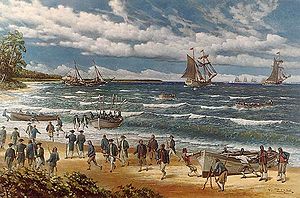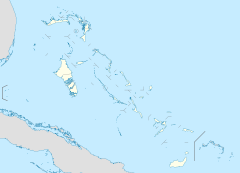- New Providence
-
For other uses, see New Providence (disambiguation).
New Providence Geography Location Atlantic Ocean Coordinates 25°02′N 77°24′W / 25.033°N 77.4°W Archipelago The Bahamas Area 207 km2 (79.9 sq mi) Length 34 km (21.1 mi) Width 11 km (6.8 mi) Highest elevation 5 m (16 ft) Country Largest city Nassau Demographics Population 248,948 (as of 2010) Density 1,594 /km2 (4,128 /sq mi) Ethnic groups African 85%, European 12%, Asian and Hispanic 3% New Providence is the most populous island in the Bahamas, containing more than 70% of the total population.[1] It also houses the national capital city, Nassau.[2]The island was originally under Spanish control following Christopher Columbus' discovery of the New World, but the Spanish government showed little interest in developing the island (and the Bahamas as a whole).[3] Nassau, the island's largest city, was formally known as Charlestown. It was laid out and renamed Nassau in 1695 by Nicholas Trott, the most successful Lords Proprietor, in honour of the Prince of Orange-Nassau who became William III of Great Britain. The three branches of Bahamian Government; the Executive, the Legislative and the Judiciary are all headquartered on New Providence. New Providence functions as the main commercial hub of The Bahamas. It is also home to over 400 banks and trust companies; and its hotels and port account for more than two thirds of the four million-plus tourists who visit The Bahamas annually. Other settlements on New Providence include Grants Town, Bain Town, Fox Hill, Adelaide, Yamacraw, South Beach, Coral Harbour, Lyford Cay, Paradise Island, Sea Breeze, Centreville, The Grove (South) and The Grove (West Bay), Cable Beach, Delaporte, Gambier and Love Beach.[4]
Contents
Etymology
The name New Providence Island is derived from a 16th‐century governor who gave thanks to ‘Divine Providence’ for his survival after a shipwreck. The ‘New’ was added later to distinguish it from a small island off British Honduras (now Belize) used by pirates.[4]
History
After 1670, Bermudian salt rakers gathering sea salt in Grand Turk and Inagua became regular visitors to the island. The first lasting European occupation was on Eleuthera and then New Providence shortly thereafter.
Because New Providence's harbour was close to the Florida Strait, it became a nest for pirates preying on mainly Spanish shipping returning to Spain with gold, silver, and other wealth. The apex of pirate activity there was from 1715 to 1725, after which the British government established a formal colony and military headquarters centered on the small city of Nassau fronting the harbour. During the War of the Quadruple Alliance, Nassau was attacked by a Spanish force, but was successfully defended by local militia.
 An artistic rendition of the Battle of Nassau
An artistic rendition of the Battle of Nassau
In February 1776, American Esek Hopkins led a squadron of over seven ships in an effort to raid the British-held island in order to secure supplies and munitions. In an event known as the Battle of Nassau, on March 3rd and 4th, Hopkins landed the first-ever amphibious assault by American military forces consisting of 250 Marines and Sailors. Under the covering fire of the USS Providence (1775) (12) and Hornet (1775) (10), the attackers overwhelmed Fort Montague. The British retreated to Fort Nassau, but then surrendered to Continental forces. The Americans managed to secure 88 cannon and 15 mortars, but most of the much desired gunpowder was evacuated before capture. Hopkins spent two weeks loading his ships with the booty before finally returning home.
The frigate South Carolina, of the South Carolina Navy, arrived at Havana on 12 January 1782. At Havana, after negotiations between Alexander Gillon and the Spanish, the South Carolina joined a force of 59 vessels carrying Spanish forces under Bernado Galvez. On 22 April the expedition sailed to capture New Providence. By May 5 the whole fleet had reached New Providence and on 8 May the colony surrendered. This was the third capture of New Providence during the American Revolutionary War.
After the American Revolution, several thousand Tories and their slaves emigrated to New Providence and nearby islands, hoping to re-establish plantation agriculture. The shallow soils and sparse rainfall doomed this activity to failure, and by the early 19th century the Bahamas had become a nearly vacant archipelago. Salt raking continued here and there, wreck gleaning was profitable in Grand Bahama, but New Providence was the only island with any prosperity because of the large British military establishment. The fortresses began to crumble and were abandoned by 1850. New Providence had two periods of high economic success during the American Civil War and during Prohibition, when it was a smuggling center.
Since 1960, New Providence has become an American vacation destination with many tourist facilities, including a deepened harbour for short-visit cruise ship visitors and hotels offering gambling. Two-thirds of the 300,000 Bahamians live on New Providence, although this proportion has fallen somewhat with the development of Freeport on Grand Bahama.
External links
- Nassau Paradise Island Promotion Board - Official Nassau Paradise Island Travel Guide
- Official Website for Bahamas Government
- Bahamas Community Message Board
Third-Scheduled Districts Grand Cay · Green Turtle Cay · Hope Town · Moore's Island · Acklins · Mangrove Cay · Berry Islands · Bimini · Crooked Island · Freeport · Harbour Island · South Eleuthera · Black Point · Inagua · Mayaguana · Ragged Island · Rum Cay · San Salvador · Spanish WellsRelated Coordinates: 25°02′N 77°24′W / 25.033°N 77.4°W
References
- ^ http://webcache.googleusercontent.com/search?q=cache:yCxJoHuHHa4J:www.blurtit.com/q702844.html+where+is+the+capital+of+the+bahamas+located+70%25&cd=2&hl=en&ct=clnk Seventy percent of the Bahamas population lives on New Providence
- ^ http://webcache.googleusercontent.com/search?q=cache:yCxJoHuHHa4J:www.blurtit.com/q702844.html+where+is+the+capital+of+the+bahamas+located&cd=1&hl=en&ct=clnk Nassau, the capital city is located on New Providence island
- ^ http://webcache.googleusercontent.com/search?q=cache:mqZBSxRg630J:www.h-net.org/reviews/showrev.cgi%3Fpath%3D2712875821430+Spanish+neglect+of+the+Bahamas&cd=9&hl=en&ct=clnkSpanish neglect of the Bahamas
- ^ a b "NEW PROVIDENCE". Government of the Bahamas. http://www.bahamas.gov.bs/wps/portal/public/About%20The%20Bahamas/The%20Islands/NEW%20PROVIDENCE/!ut/p/b1/vVTJkqJAEP0WP6CbYpPiWCwiWOwFAhcDRWhQFpVF_Pqx5zJLxHRfpjvzlBEv3ov3MiOphIqopEnHskj7sm3S8_ucLHcs0EyEOGhqPFgCPXAwcoQ1Y9M8taUiEjN3pdUnTffyzu2rYJpXvWzKWrGXtI0t3fOHi6otY4SGmJe3gYyZOASD3W9IXyVj5hlt4Vi-sGVS6wTjVZtj3rIwOSZGuxd3R9G6woN4Tc7Aye9eXAOsQH6IZiTbMDSDcB3s6O4w40056CPfv51VfUgr_yoGF9erUHr3taY2D1ksXbCyTTK9UWdPn-yzczygfn1rGg6lueHe3MXiaTj-wDAHPs8j-RDyzvATAP5RCHzCsGEoa93WRyp-woTfYCQEQKcB8nzaBdCiKUJFgNv51dzpj9PDq8B8NxWVsfYIgH0ASHANLLKyzMynfcXANAmxKcSTT-w7wTHwM-JkoRdISLnAJnT-FrQZIj4FZXq5CXjgA-6rBTXehs8gBOIgngGaTX-3IPutkWqODb7c4R9Hw7n_f4cGlZT7-nU61K_gFYpLmhcgJ8Il4DgoUGEVL3nlpk-q6u2MmMa3i9C5RaGXwU0v0pVUQ6KfoocRFRV03DiVEBuOVp1xrYaKGc8ujJ9-bi8CcyEW5Ka8clLvlogHma2wh302GDWNyYxtiyuZ4dRiXK_SRr-wbK4NPJHmk7c39nY3LJM66kQH1x3bHmde26zkYqeKDdha_Yk-b4_MQ9ymdM0x1yRspJxPxevGiszSs4Rp80aausuyjFO0olwrzPPlEEZQFSjrCqci5W6k8ghfdAkqZXQqno-mq0e89NYTDX_1hBaLH17e3Nw!/dl4/d5/L2dBISEvZ0FBIS9nQSEh/.
Categories:- New Providence Island
- Districts of the Bahamas
- Islands of the Bahamas
Wikimedia Foundation. 2010.

